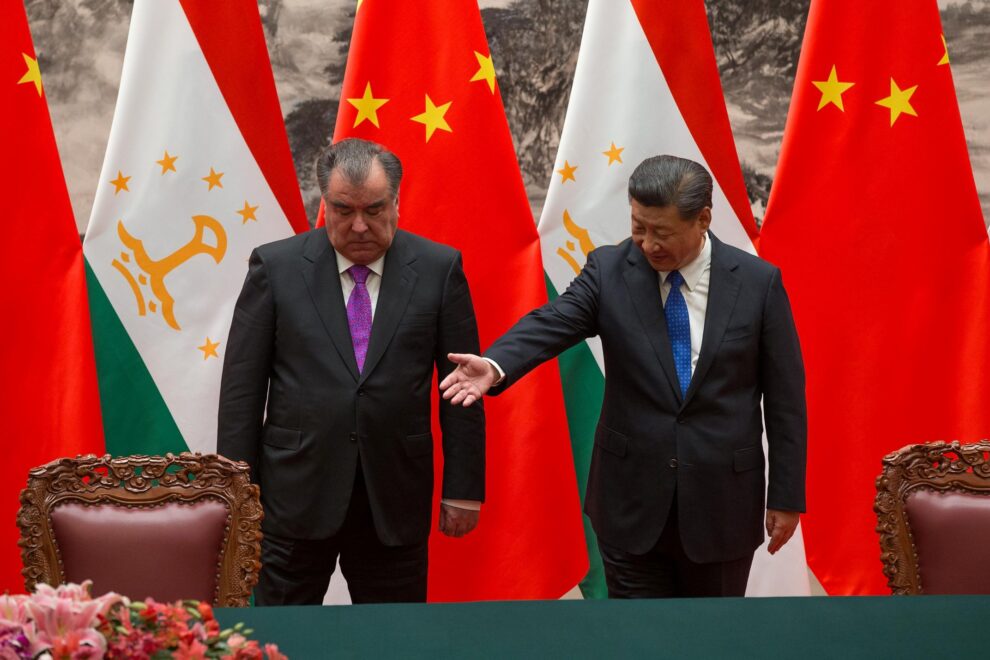Tajikistan is one of the smaller Central Asian nations, yet bordering China has a key role to play within China’s reach West. In this article we examine the BRI from the Tajikistan perspective, look at development trends and the opportunities resulting from the countries participation within the Middle Corridor and increasing Central Asian integration.
The China-Tajik approach and Beijing’s goals
China and Tajikistan established formal diplomatic relations in 1992. By putting away their border dispute in 2011 (handing over 1158 square kilometers of land to China), the two sides gradually expanded their economic cooperation by expanding cooperation in bilateral and multilateral frameworks such as the Shanghai Cooperation Organization.
The Belt and Road Initiative (BRI), launched by Beijing in 2013, seeks to connect Asia to Africa and Europe, with the aim of improving regional integration, increasing trade, and stimulating economic growth. It also connects China to Southeast Asia, South Asia, Central Asia, Russia, and Europe. The China-Europe BRI corridor connects China to Europe, using two routes. But the China-Central Asia-West Asia BRI Corridor connects China to West Asia using three routes. One of the routes is the China-Kyrgyz Republic-Tajikistan-Afghanistan-Iran section, which connects with the INSTC and onto the Middle East, South Asia, East Africa and Europe.
The Chinese government considers the BRI to be based on “China’s national ideal”, a form of South-South cooperation, equality, respect for the opinions of other developing countries, and agreement with them. Beijing’s focus on its Asian neighbors and the regional aid package on the 30th anniversary of bilateral relations between China and Central Asian countries in January 2022 shows Beijing’s attention to Tajikistan.
In fact, China with BRI in Tajikistan seeks to expand transportation and logistics infrastructure, trade links, prosperity, new opportunity for stability and growth, investment, technology and new markets, exports, industries, industrial promotion, green and digital economy, reducing electricity shortage, and increasing exchanges.
In recent years, especially in 2022, besides signing 18 agreements, China and Tajikistan are considering the signing of more cooperation documents, a strategic map for relations, increasing communication, and strengthening economic, commercial, and investment cooperation.

Although only one route of the BRI corridor passes through Tajikistan, the country was among the first to sign a memorandum of understanding with China and officially joined the Belt and Road Initiative in 2018. Therefore, since the announcement of BRI, various investments have been made. Also in 2020, the two sides signed five new loan projects worth US$459.5 million, and in 2021 announced plans to borrow an additional US$562 million.
According to the CADGAT report, Tajikistan has 44 projects in which China has invested or projects in progress. These range from roads, and railways to pipelines and electricity, mining, agriculture, industrial zone creation, thermal power plants, and so on, and have been or are in the process of being completed. Some 300-400 Chinese companies are registered or are conducting investment activities in Tajikistan, including for example highway construction. Taking this context, the Belt & Road Initiative can be viewed as an enormous version of typical Western nations commercial consular activities – only far better coordinated and with a better-defined relationship between Government-financed consular knowledge and the Chinese industrial and commercial sectors.
The reconstruction of the highway between Tajikistan and Uzbekistan, the highway to Afghanistan, the construction of tunnels under the mountain passes, the rehabilitation and reconstruction of the Dushanbe-Border-China highway), the Vahdat-Yuvan railway, and the longest tunnel in Central Asia are part of BRI operations in Tajikistan. Yet these aim not just to benefit China exclusively but make use of Tajikistan’s geographical position and better integrate it with its own neighbours.
In the electricity sector, projects such as Dushanbe’s 400 MW main power plant, Roghun Dam power generator, city heating system, and 500 kV South-North, and the Tajikistan-Kyrgyzstan CASA-1000 transmission line have been completed or will be completed.
Mining has taken a major share of the BRI and industrial parks, as have Free Economic Zones (FEZs) such as Danghara, http://fezdangara.tj/ the new parliament building and the construction of the city hall are other important Chinese investments into Tajikistan. In fact, the BRI has focused on increasing production capacity, minerals, infrastructure, e-commerce, artificial intelligence, and agriculture, and promoted mutual communication.
Tajikistan’s BRI perspective
With no significant change in foreign policy orientations, Tajikistan seeks to diversify its international relations and attract foreign direct investment. Reconstruction and expansion of infrastructure in Tajikistan is also a strategic need, and without loans, the implementation of projects will be impossible.
China’s advantage over other partners is the principle of non-intervention and lack of mandatory conditions and reforms. With a per capita income (GNI) of nearly US$1,000 and Nearly one-third of the country’s population being poor, Tajikistan is seeking to achieve the desired goals for economic well-being through the BRI in Tajikistan’s National Development Strategy 2030 (NDS).
Tajik politicians are familiar with the special conditions of Chinese investment and its consequences, and the “Chinese threat theory” does not exist in Tajikistan. Therefore, Dushanbe announced its readiness to continue strengthening cooperation with China as part of BRI and it is compatible with “Tajikistan’s national development strategy until 2030 and attracting US$55 billion dollars in foreign investment”.
The BRI in Tajikistan: Challenges
Despite the BRI, strategic reforms and further investment in Tajikistan are needed for sustainable and inclusive economic development. Tajikistan still has the lowest trade volume with China in Central Asia. The size of the loans is disproportionate to the size of the economy, and Tajikistan does not have a good ranking in the World Bank’s business reports and is at risk of debt problems. Tajikistan owes about US$3.3 billion to foreign investors, but much of that is owed to China’s state-owned Export-Import Bank (Eximbank). That is an economic calculation – largely made at reduced interest rates – repayable against Tajikistan’s trade figures. As Tajikistan’s foreign trade was up over 20% in 2022, it is a bet that appears likely to be repaid in full and with substantial longer term benefits.
Although this increase in debt has wider consequences such as economic dependence on the host, political and economic systems of countries, strategic investments, and transactions. while the capacity of Tajikistan’s domestic market is limited, it is not expected that the prosperity of Tajikistan will improve only by improving the infrastructure. For that reason much of the Tajikistan 2030 national development plan positions the country as a regional transit hub with the ability to provide added value China-Overseas trade services, such as product consolidation, repackaging and warehousing.
But certain political and security problems may jeopardize the complete and successful implementation of the projects. In another dimension, the environmental effects of large infrastructure projects are important, while considerations need to be made as how to minimize the environmental effects.
Foreign Investor Belt & Road Initiative opportunities and prospects in Tajikistan
China’s BRI as been contributing to Tajikistan’s communication, transportation, economic integration, improvement of cross-border transportation infrastructure, electricity, and information technology. It also has an important impact on increasing exports, foreign direct investment, and gross domestic product, and reducing risks and financial risk. From this point of view, the BRI has provided new opportunities for the development of a green and digital economy in Tajikistan.
The improvement of highways and border crossings with Uzbekistan, Kyrgyzstan, and Afghanistan will activate Tajikistan’s trade potential with its neighbors and open economic opportunities. Trade with Beijing has expanded, and China has become the largest source of investment for Tajikistan. In addition, the successful implementation of BRI will encourage Beijing to invest more in Tajikistan.
Completion of BRI transport projects will increase Tajikistan’s total exports, reduce border delays, and have an increasing impact on GDP, competitiveness, and export in the larger economy. Agriculture is an underdeveloped pillar of Tajikistan’s economy. Tajikistan seeks to improve food security in its national development strategy for the period, up to 2030. This has become more accessible with BRI projects being completed and the cash flow generating trade results coming to fruition.
Agreements such as Tajikistan’s Bilateral Investment Treaties (BIT), the China-Tajikistan Double Tax Avoidance Agreement (DTA), and the China-Tajikistan Comprehensive Strategic Partnership are all helping create opportunities not just for Chinese, but other foreign investors too. Projects already implemented are further strengthening the country’s emerging oil and gas infrastructure and resources, along with an increasingly open economic policy and political stability.
On the other hand, Tajikistan’s position is important for the success of the BRI and can host the import of natural resources from countries such as Uzbekistan or the Turkmenistan-China gas pipeline. Also, the Central Asia-South Asia Energy Line (CASA-1000) may be completed as a BRI project.
The BRI is also providing an opportunity for Pakistan and Tajikistan to work together on CPEC. As and when Tajikistan is connected with the Turkmenistan-Afghanistan-Tajikistan railway, it will connect with Iran, and therefore the INSTC connectivity project leading to markets in the Middle East, South Asia, East Africa and Europe.
Summary
All BRI-related projects in Tajikistan are scheduled to be implemented in the next several years meaning that Tajikistan’s role in regional Eurasian trade is highly likely, barring any serious issues, to rapidly expand. This is reflected in the countries current economic performance. Tajikistan’s 8% GDP growth last year (2022) and an additional growth forecast of 6.5% for 2023 indicate the increasing effects of the BRI in the country.Considering the signing of new cooperation documents and the China-Tajik investment and cooperation memorandum for 2023-2024 expectations are high for a successful implementation of the BRI in Tajikistan, leading to significant growth opportunities in coming years.
Source : Silk Road Briefing















